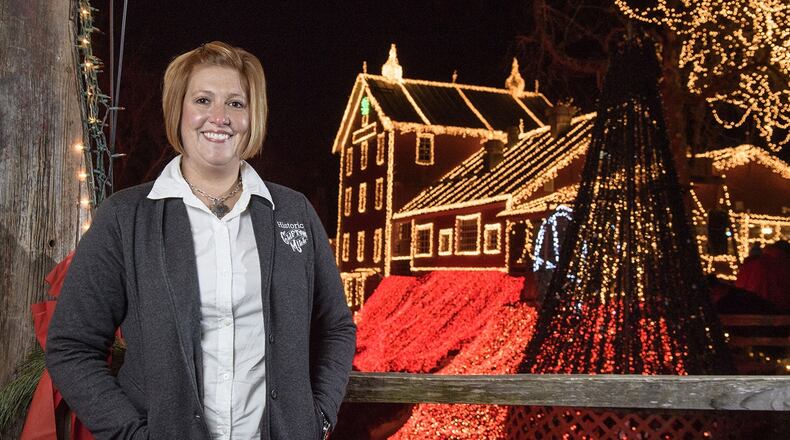It was simply irresistible.
Jessica Noes had begun working at the historic Clifton Mill in high school and continued during her college years at Wright State University. When she graduated, she launched what she thought would lead to a high-powered business career in the corporate world, starting with managing a makeup counter at a retail store.
But the siren song of the old mill never died. And when the owner offered to make her general manager in 2006 and “get her master’s in running her own business,” she jumped.
Today, Noes oversees all operations at the mill. Her duties include staff scheduling, customer relations, accounting and marketing.
“There is a charm to the mill,” she said.
Credit: © Wright State University Photo
Credit: © Wright State University Photo
In 2018, Clifton Mill won the top prize of $50,000 on ABC’s “The Great Christmas Light Fight,” which featured a competition among the most spectacular Christmas lights displays in America. And in 2021, the mill placed third in the USA Today contest’s “Best Public Lights Display” category.
The red, seven-story mill was built in 1802 next to the Little Miami River overlooking Clifton Gorge in the tiny southwest Ohio village of Clifton, home to about 150 people.
The working mill, which grinds grain into flour, is one of the largest remaining water-powered grist mills in the land. The multilevel structure is freighted with a hopper, dust catcher, corn sifters, mixers, grinding stones and storage bins. A water turbine powers the process.
A log cabin, a historic covered bridge, a 20-foot water wheel and a restaurant also populate the site, which sits next to a waterfall that staircases down into the gorge.
Flour from the mill is used to make the restaurant’s signature 12-inch pancakes and is sold in the gift shop, which is perfumed with the smell of popcorn and soft pretzels.
“What is different about the mill is that it is a destination,” said Noes. “People are coming to the mill for a special day out, not just for dinner. The business has definitely grown since I’ve been here.”
But the real jewel in the crown of Clifton Mill is its Christmas display, which has grown to 5.1 million lights that produce a heart-stopping electric bill but dazzles visitors.
Credit: © Wright State University Photo
Credit: © Wright State University Photo
The light show is the brainchild of the Satariano family, who purchased the mill in 1987 and installed 100,000 Christmas lights in 1988.
An eight-member crew begins putting up the lights in September. Bucket trucks are used to tinsel the towering mill and 70-foot-high trees with the bulbs.
The light shows begin the day after Thanksgiving and run through Dec. 30. The electric bill for December runs into the tens of thousands of dollars. To minimize weathering, most of the lights are then taken down and stored away, a process that takes about three months.
“The Christmas lights grow every year because we’re always adding something new,” said Noes. “We purchase a good bit of new lights every year.”
During the holiday season, Noes manages a staff that balloons from between 20 and 30 to about 40. She has learned to become a jack of all trades and fast on her feet.
The mill and its romantic charm have played host to numerous weddings over the years. Couples who get engaged at the mill are allowed to carve their initials on the covered bridge.
“It’s unbelievable how many people have had their hearts touched by this place,” said Noes.
Noes even once witnessed a group of people using the water wheel to spread the cremated ashes of a loved one into the river.
“That was a crazy one,” she said.
About the Author


